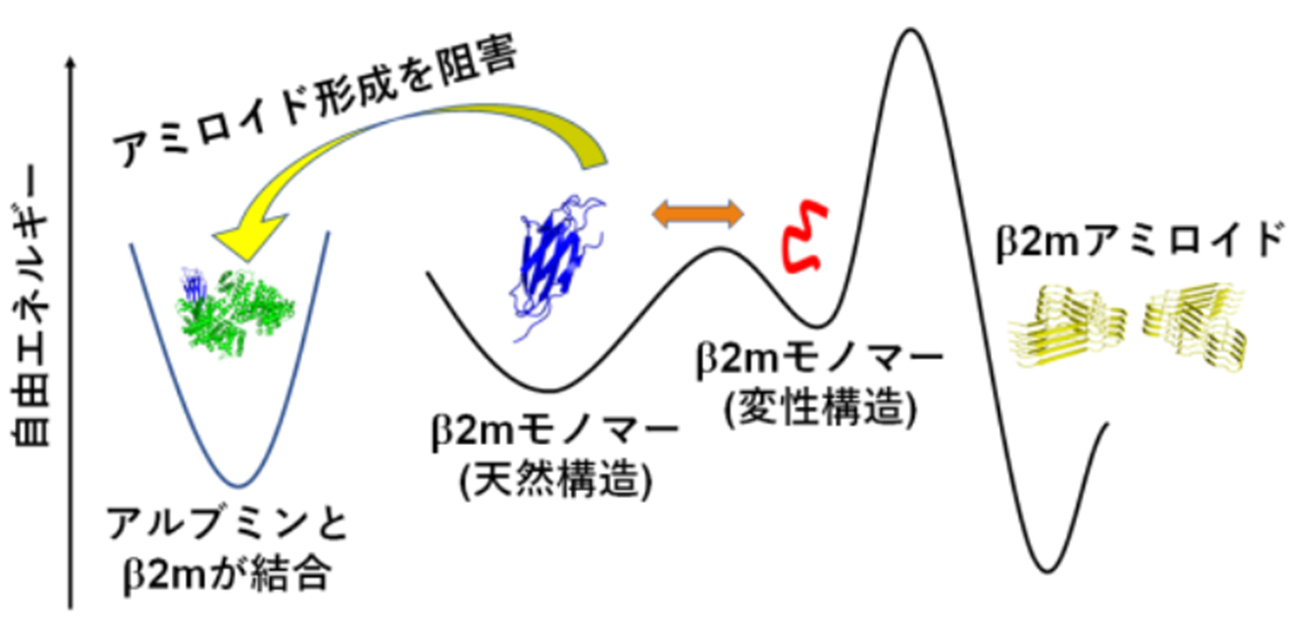
Serum albumin could prevent amyloid fibril formation in dialysis patients
Researchers from Osaka University find that albumin interferes with β2m amyloid fibril formation through macromolecular crowding, thereby reducing dialysis patients’ risk of developing dialysis-related amyloidosis
Dialysis is a lifesaving technique that artificially filters blood; however, it has some harmful side effects. Now, researchers from Japan have found that monitoring a normal blood component could help prevent one of the more serious complications of long-term dialysis.
In a study in Nature Communications, researchers from Osaka University reveal that a high concentration of a key molecule found in blood can prevent dialysis-related amyloidosis (DRA).
Approximately 350,000 patients in Japan in 2021 were on dialysis due to end-stage kidney disease. Ten percent of patients who are on dialysis for more than 15 years develop DRA, which occurs when β2-microglobulin (β2m) clumps together to form long strings known as amyloid fibrils.
“Previous studies have shown that high serum β2m concentrations and dialysis vintage are the primary risk factors for developing DRA,” says Kichitaro Nakajima, first author of the study. “However, not all patients with these risk factors develop the condition.”
To identify additional risk factors for developing DRA, the researchers tested the effects of serum, which is the protein-rich liquid part of blood, on β2m fibril formation. They also looked at the effects of serum from patients who were new to dialysis versus long-term dialysis patients, as well as the effects of serum samples taken immediately before or immediately after a dialysis session.
“The results showed that serum albumin, the most abundant protein in serum, markedly inhibits β2m amyloid fibril formation,” states Yuji Goto, senior author of the study. “This effect was ameliorated by maintenance dialysis in the short term but deteriorated in dialysis patients in the long term.”
More detailed investigations revealed that the inhibitory effect of serum albumin on β2m amyloid fibril formation was due to a phenomenon called macromolecular crowding, in which weak nonspecific interactions between serum albumin and β2m interferes with the ability of β2m to form fibrils. Maintenance dialysis temporarily increases the serum albumin concentration, and therefore decreases the risk of developing DRA, whereas decreased serum albumin concentrations in patients with kidney failure lead to an increased risk of DRA over the long term.
“Taken together, our findings show that low serum albumin concentrations are a risk factor for dialysis patients developing DRA,” states Nakajima.
These findings suggest that monitoring serum albumin concentrations in patients on long-term dialysis could help predict, and ideally delay, DRA onset. Furthermore, given that reduced serum albumin also correlates with the onset of Alzheimer's disease, this risk factor could also be applicable to other amyloidoses.
Fig.1
(Left) The HANABI-2000 apparatus enabled us to investigate the effect of serum samples derived from dialysis patients on b2-microglobulin amyloid fibril formation. We named this instrument HANABI because it uses ultrasonication to induce synchronized amyloid formation which looks like a fireworks going off (“hanabi” means fireworks in Japanese.) (Right) Photo of 2022 Nagaoka fireworks festival (Nagaoka city, Niigata prefecture, Japan).
Credit: Kichitaro Nakajima, Suguru Yamamoto, and Yuji Goto
Fig.2
Dialysis-related amyloidosis is caused by the deposition of b2-microglobulin amyloids. The white deposits on the wrist tendon in the picture are mainly composed of b2-microglobulin amyloids. Previous research into dialysis-related amyloidosis has shown that the primary and secondary risk factors for this disease are an aberrant increase in blood b2-microglobulin concentration and a long dialysis vintage. However, not all patients with these risk factors develop dialysis-related amyloidosis, implying that there are other, unknown, risk factors that should be identified to help prevent the development of dialysis-related amyloidosis. Professor Fumitake Gejyo (co-author of this study) of Niigata university was the first to report that b2-microglobulin aggregation is causative for dialysis-related amyloidosis [Gejyo et al., Biochem. Biophys. Res. Commun. 129, 701-706 (1985)]. As of 2022, one out of 380 Japanese citizens receive dialysis treatment. In patients who started dialysis treatment in 2010 cohort, who have a dialysis vintage of more than 20 years, the risk of developing dialysis-related amyloidosis is 10% [Hoshino et al., Nephrol. Dial. Transplant. 31, 595-602 (2016)].
Credit: 1. F. Gejyo et al., N. Engl. J. Med. 314, 585-586 (1986).
2. S. Yamamoto et al., Biochim. Biophys. Acta 1753, 4-10 (2005).
Fig. 3
In this study, we found that a decrease in serum albumin facilitates b2-microglobulin amyloid formation. Long-term dialysis results in lower serum albumin concentrations in dialysis patients compared to healthy people, and is a risk for amyloid formation. Our findings indicate that maintaining healthy serum albumin levels through appropriate management of nutrient status and frequent dialysis treatment can help prevent the development of dialysis-related amyloidosis.
Credit: Kichitaro Nakajima, Suguru Yamamoto, and Yuji Goto
The article, “Macromolecular crowding and supersaturation protect hemodialysis patients from the onset of dialysis-related amyloidosis,” was published in Nature Communications at DOI: https://doi.org/10.1038/s41467-022-33247-3.
Related Links
Yuji Goto (Researcher Directory)
Goto Laboratory


